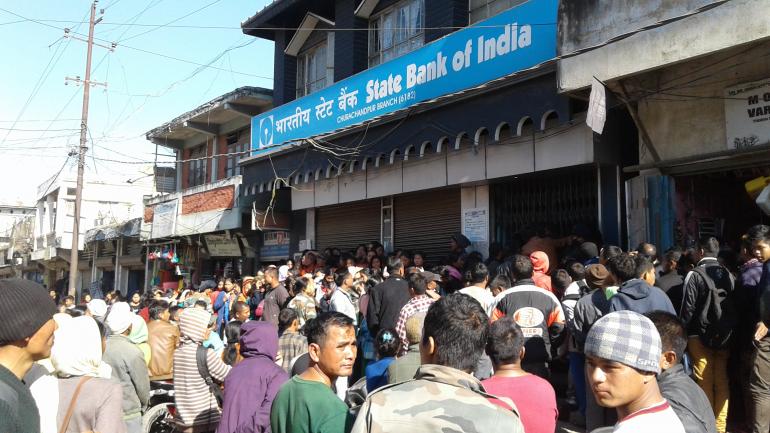
Photograph during demonetisation, economic blockade in Manipur and coupled with internet shutdown during 17 - 30 December 2016. Image source: author.
When the people of Manipur are grappling with the swift transition in information and communication technology, the Bachchao Project’s study titled Of Sieges and Shutdowns - How unreliable mobile networks and intentional internet shutdowns affect the lives of women in Manipur, is a timely and crucial intervention. More so, given the context and situation where internet ban and shutdowns, poor unreliable mobile service has been frequently experienced by people of Manipur. The issue of shutdowns and ban has never been a subject of study or deliberation among intellectuals, academia, civil societies or concerned citizens at large. This study, the first of its kind, is an eye-opener.
This study, the first of its kind, is an eye-opener.
The subject matter is an emerging issue as mobile phones are widely used by people in Manipur and have become one of the most important means of communication and information exchange either on the personal or professional front. The sudden shutdowns, internet ban and unreliable services have impacted the lives of people, women in particular at different levels – individually, professionally and socio-economically.
Impact of unreliable services, internet shutdowns that the study has brought out is insightful. It brings out the hardships faced by women and the Manipuris at large, which otherwise were never surveyed or really considered an “issue” or a “problem” that needed attention. An in-depth study of the impact holds out hope for better communication and information sharing in Manipur.
Specific impacts explored in the report
Economic loss is an important area that the Bachchao Project study looked into. During shutdowns, bandh, blockade, additionally with internet shutdown, there is a huge unaccounted economic loss. The financial impact had never been studied or investigated and no statistics are available, including the effects on loss of working hours and productivity due to these shutdowns and ban or blockades. Bringing this out in the study is indeed a crucial and significant finding.
It is indeed not an easy task. The challenges are daunting. For one, there is no document for references or literature. This has all the more made the study relevant, making it a reference for social and economic studies in and of Manipur. Another challenge the researcher(s) emphasize on is the (mis)trust between the researcher(s) and the respondents. In the midst of the numerous challenges – socio-political, lack of secondary sources, literature and difficulty in bringing respondents together for an in-depth interaction and the fear that it could hamper the study, the researcher(s) had managed to build a good rapport and that is quite an achievement, though the researcher(s) appear a bit too sensitive or rather too self-conscious of their being a “mainlander”. The (mis)trust which the researcher(s) experienced is basically about people, specifically women (here the respondents) taking time to open up. Being a conflict statei this is a natural phenomenon. Respondents are either being cautious or in doubt of what the survey actually is all about. This is also due to the fact that there are numerous instances of misquoted reports and misinterpretation of/about Manipur by non-local writers or researchers or most importantly the ‘national’ mediaii.
The (mis)trust which the researcher(s) experienced is basically about people, specifically women (here the respondents) taking time to open up. Being a conflict state this is a natural phenomenon.
Background to the context in Manipur
While the study largely dwells on the impact of internet shutdowns and unreliable mobile communication services, it missed out on the background – why frequent shutdown, suspension of mobile internet service and ban on internet communication have been ordered and imposed in the state of Manipur. The reason may be obvious but it is an important background settingiii. This brief information of the reason for shutdown could have provided a comprehensive view of the situation of the state. This would also provide more in-depth understanding and perhaps add to the findings and recommendations. The study jumps directly on to the impact of the shutdowns and bans of services. This made it appear oriented towards activists who are already aware.
Notification of bans and shutdowns
The study report stated that there is no information regarding internet shutdowns. This is a bit of an exaggeration and contradictory. While it mentioned “No public notification issued on shutdowns”, it also mentioned (in page 32) that from 17 to 30 December 2016, all operators of wireless internet service provider were prohibited in East and West Imphal by order of District Magistrate to restrain the circulation of rumours. Daily newspapers, local TV channels reported about the shutdown orders and information are going viral on social media – specifically Facebook and WhatsApp. Therefore, it cannot be said that the general public is unaware or uninformed.
Reasons for non-functioning of services of internet or mobile phone are many. Some of it could be due to reasons of technical failure which is frequent in Manipur or north-east region at large. The Kangpokpi case (page 34) could be the fallout of technical failure or due to traffic congestion of the service(s) ahead of the state assembly election. However, there was no detailed probe into why this was happening.
Reasons for non-functioning of services of internet or mobile phone could be due to reasons of technical failure which is frequent in Manipur or north-east region at large.
The Kangpokpi case is a classic example of how a lack of clarity about the disruption of communication services leads to rumour and fake news.

Photograph of street outside bank in Manipur during demonetisation and network shutdown during 17 - 30 December 2016. This photograph was taken just before Christmas - 22nd and 23 december 2016. Image source: author.
Selection of respondents for the study
Much as Manipur has diverse communities, the selection of respondents has been accomplished with sensitivity by including people from the valley and hills based apparently on ethnic differences. It could have been even more insightful if the categorization was done on basis of economic status or, on basis of rural and urban dwelling. Since internet users vary according to “class” and privileges, mostly based on economic status of the people. More users would be found in urban rather than rural areas and this will be determined more on their “economic class” rather than their “identity”.
The findings indicate that 14 out of 16 respondents use smart phones – these are from urban/ semi-urban and mostly people with income, including women and activists. Internet and smartphone is a necessity for urban/semi-urban and working women but for rural women/cultivators/homemaker smart phones or internet are still a “luxury”. Be that as it may, most people use simple mobile phones. This raises a question if the study is adequate enough to understand the simple mobile service (without internet service) which is largely the basic mode of communication among people in rural areas.
For rural women/cultivators/homemaker smart phones or internet are still a “luxury”.
Varied uses of internet and social media
All respondents in the study say they use social media. It can be questioned if these 16 respondents can be seen as adequately representative of the 1,417,208 female population of Manipur (2011 census) wherein majority are in rural areas. Social media users are mostly the younger generation and those in urban / semi-urban population. Majority of Manipur population use mobile communication, but social media/ internet does not reach the entire population of mobile users, particularly women, not only because of the poor service but because not all are dependent on the internet for their livelihood or for communication. Many are still agriculturists or daily wage earners and women who are mostly home base workers or homemakers.
It is true that social media platforms like WhatsApp and Facebook are used for public mobilization. However, the use of Twitter which is a popular medium for drawing the attention of authorities is not widespread in Manipur. People do not prefer to use internet banking as internet services are unreliable, besides the general observation that they are not confident about internet banking.
The use of Twitter which is a popular medium for drawing the attention of authorities is not widespread in Manipur.
Low quality and service in the region
The study flags the important issue of “consumer relief for the low quality of service”. Most staff/ employees at the office of the service providers proved not competent enough to resolve issues. These service provider offices are merely for a recharge or getting a new SIM card. In most cases, issues/problems with phones or services are referred to the state capital Imphal. To put it bluntly, customer care is poor, particularly in the hinterland.
In light of tall programmes like Digital India, northeast India in general and Manipur, in particular, require a massive awareness programme about digital information technology.
Concluding remarks
Overall the study is an important document capturing the positive and negative aspects of the new-age information technology and communication. Crucially, the document brings out and flags the impact of this technology and its disruptions on women and the economy of Manipur. This study will serve as an important reference for further investigation, research on the use, misuse, impact of mobile phones, wireless communications and digital technology.
i Phanjoubam P. (February 28, 2016). The face of another nationalism. The Indian Express. https://indianexpress.com/article/india/india-news-india/jnu-row-the-fa…
Phanjoubam P. (February, 2004). Manipur: the search for solutions. Faultlines Journal, Volume 15. http://old.satp.org/satporgtp/publication/faultlines/volume15/Article5.htm
ii Haskar N. (September 23, 2010). Constitutional crisis in Manipur. Manipur Online
http://manipuronline.com/edop/opinions-commentary/constitutional-crisis-in-manipur/2010/09/23
Raj, S. (December 1, 2016). From Marginalisation to Stereotypes — ‘North East India’ in Indian Media: Evidences from Focus Group Discussions in Manipur. Journal of North East Studies.
https://www.freewebs.com/jneis/pdf/vol.6/6.2.5.pdf
iii Internet blocked in Manipur to quell violence (September 3, 2015). https://www.livemint.com/Politics/ZFX1zHdhZ827jnqirpzZqO/Internet-blocked-in-Manipur-to-quell-violence.html
Manipur police appeal for sanity, explain social media shutdown. (July 20, 2018). E-pao. http://e-pao.net/GP.asp?src=18..210718.jul18
- 5386 views






Add new comment